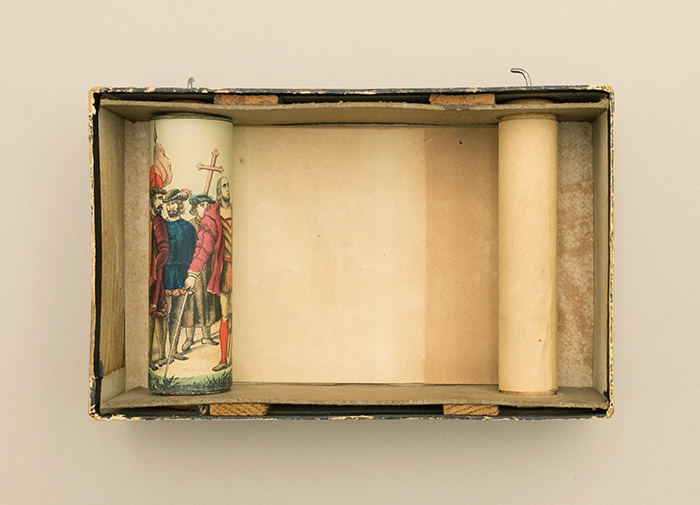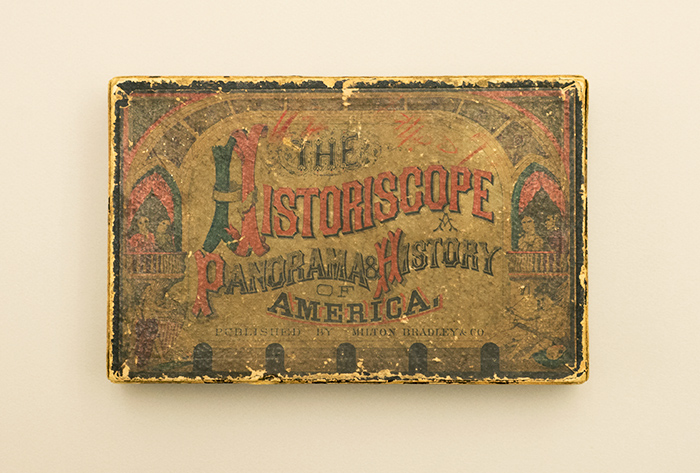The blog of The Huntington Library, Art Museum, and Botanical Gardens.
LOOK>> A Historiscope
Posted on Fri., Oct. 2, 2015 by and
With LOOK>>, we venture into our wide-ranging collections and bring out a single object to explore in a short video. This time around, we look at Milton Bradley & Company’s Historiscope, ca. 1870.
While we often think of Milton Bradley as the toy company that produced such classics as The Game of Life and Connect Four, the company was once an influential early producer of school supplies. Milton Bradley, the founder of the company, was a lithographer who became interested during the 1860s in the educational reform movement to establish kindergartens. He began focusing on creating games and toys that could be used to educate young children.
One such toy was The Historiscope: A Panorama and History of America, a small box containing a long panoramic paper roll featuring 25 scenes (only a few of which are shown in the video due to the fragility of the object). As one scrolls through the panorama, the historic tale that unfolds is one that is very much of its time, as histories tend to be. In one scene, Columbus proudly stands on a New World shore; in another, the Earl of Cornwallis’s army surrenders at Yorktown. A tour across this panorama today is surely a different experience than it would have been then, and it’s fun to imagine what scenes might be depicted if such a toy were created today.
 The Huntington’s Historiscope, viewed from the back, reveals the long paper scroll of the panorama wound around rollers.
The Huntington’s Historiscope, viewed from the back, reveals the long paper scroll of the panorama wound around rollers.The panorama is framed by an illustration of a miniature theater—complete with balconies, curtains, stage lights, and theatergoers—and the whole contraption is only about 8 inches wide. During its heyday, the toy came with little tickets for attendees and an educational lecture to accompany the visuals. (The Huntington’s specimen doesn’t include the lecture or tickets.) Pre-cinematic “edutainment” at its finest!
The Historiscope is one of more than 185,000 printed objects comprising the Jay T. Last Collection of Graphic Arts and Social History. Featuring works by more than 500 lithographic companies, the Last Collection provides insight into U.S. society and business of the 19th and 20th centuries, as well as the history of lithographic printing. Today, we take color for granted, but lithography introduced color to 19th-century Americans’ otherwise black-and-white print world.
Decades before the advent of cinema, the lithography of the Historiscope offered children a glimpse into a moving, brightly colored history of America that could be watched over and over again.
 The well-worn cover of The Historiscope: A Panorama and History of America, published by Milton Bradley Co., ca. 1870, toy panorama with hand-colored lithographs, 8 1/4 x 5 1/4 x 2 1/2 in. The Huntington Library, Art Collections, and Botanical Gardens.
The well-worn cover of The Historiscope: A Panorama and History of America, published by Milton Bradley Co., ca. 1870, toy panorama with hand-colored lithographs, 8 1/4 x 5 1/4 x 2 1/2 in. The Huntington Library, Art Collections, and Botanical Gardens.Also in this series:
LOOK>> Spelling Slips (Aug. 1, 2016)
LOOK>> A Printed Fan (Dec. 3, 2015)
LOOK>> An Ant Plant (Nov. 9, 2015)
LOOK>> A Myriorama (Sept. 1, 2015)
Olivia Hummer served as an intern in the office of communications and marketing at The Huntington.
Kate Lain is the new media developer at The Huntington.